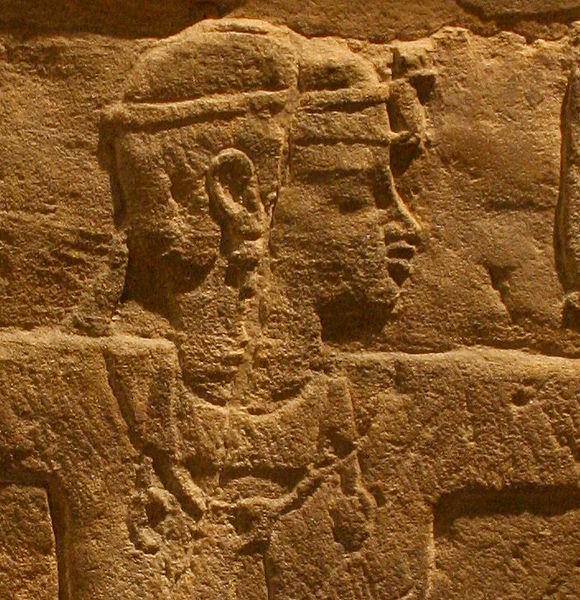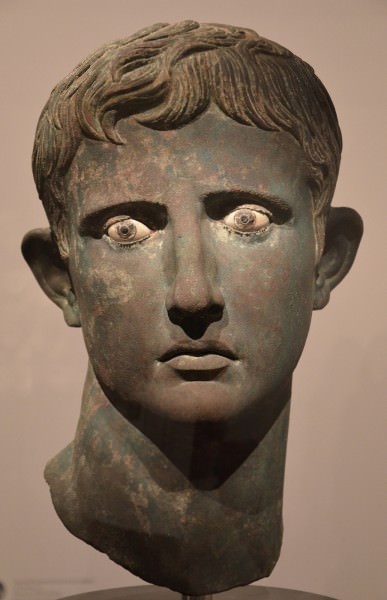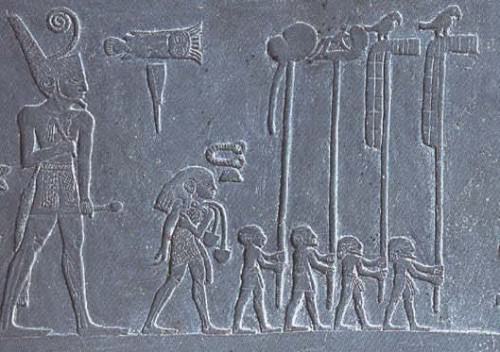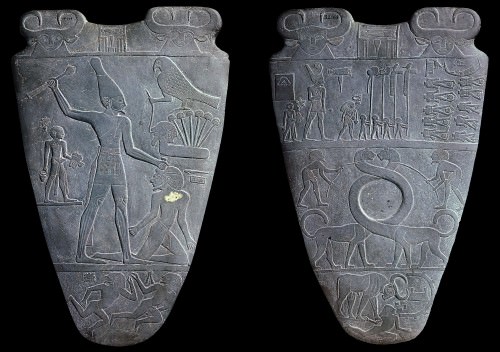Meroe › Narmer » Ancient origins
Articles and Definitions › Contents
- Meroe › Antique Origins
- Narmer › Who Was
Ancient civilizations › Historical and archaeological sites
Meroe › Antique Origins
Definition and Origins

Meroe was a wealthy metropolis of the ancient kingdom of Kush in what is today the Republic of Sudan. It was the latter day capital of the Kingdom of Kush (c. 1069 BCE-c.350 CE) after the earlier captial of Napata was sacked in c. 590 BCE. Prior to that date, Meroe had been an important administrative centre south of Napata. The city was located at the crossroads of major trade routes and flourished from c. 750 BCE to 350 CE.
As no one yet has been able to decipher the Meroitic script, very little can be said for certain on how Meroe grew to become the wonderous city written about by Herodotus in circa 430 BCE, but it is known that the city was so famous for its wealth in ancient times that the Persian King Cambyses mounted an expedition to capture it. The expedition faltered long before reaching the city owing to the difficult and inhospitable terrain of the desert (and, according to some claims, may never have been mounted at all). Still, the persistence of the story of Cambyses' expedition suggests the great fame of Meroe as a wealthy metropolis.
The city was also known as the Island of Meroe as the waters flowing around it made it appear so. It is referenced in the biblical Book of Genesis (10:6) as Aethiopia, a name applied to the region south of Egypt in antiquity meaning "place of the burnt-faces". Although there is evidence of over-grazing and over-use of the land, which caused considerable problems, Meroe thrived until it was sacked by an Aksumite king in c. 330 CE and declined steadily afterwards.
EGYPTIAN INFLUENCE & KING ERGAMENES
While there was a settlement at Meroe as early as 890 BCE (the oldest tomb discovered there, that of 'Lord A', dates from that year), the city flourished at its height between c.750 BCE and 350 CE. The Kingdom of Kush, founded with its capital at Napata, was ruled by Kushites (called "Nubians" by the Egyptians) who, early on, continued Egyptian practices and customs and, though they were depicted in art as distinctly Kushite, called themselves by Egyptian titles. The historian Marc Van De Mieroop writes:
Meroitic culture shows much Egyptian influence, always mixed with local ideas. Many temples housed cults to Egyptian gods like Amun (called Amani) and Isis, but indigenous deities received royal patronage as well. A very prominent Nubian god was the lion-deity Apedemak, a god of war whose popularity increased substantially in this period. Local gods were often associated with Egyptian ones: in Lower Nubia, [the god] Mandulis, for example, was considered to be Horus 's son. Hybridity is also visible in the arts and in royal ideology. For example, kings of Meroe were represented in monumental images on temples in Egyptian fashion but with local elements, such as garments, crowns, and weapons. (338).
In time, however, these practices gave way to indigenous customs and the Egyptian heiroglyphs were replaced by a new system of writing known as Meroitic. The break from Egyptian culture is explained by the ancient historian Diodorus Siculus who writes that in the time before the reign of King Ergamenes (295-275 BCE), it had been the custom for the high priests of the Egyptian god Amun at Napata to decide who became king and to set the duration of the king's reign.
As the health of the king was tied to the fertility of the land, the priests had the power to determine if the sitting king was no longer fit to rule. If they deemed him unfit, they would send a message to the king, understood to be from the god Amun himself, advising him that the time of his rule on earth was completed and that he must die. The kings had always obeyed the divine orders and had taken their own lives for the supposed good of the people. However, Diodorus continues:
[Ergamenes,] who had received instruction in Greek philosophy, was the first to disdain this command. With the determination worthy of a king he came with an armed force to the forbidden place where the golden templeof the Aithiopians was situated and slaughtered all the priests, abolished this tradition, and instituted practices at his own discretion.
The archaeologist George A. Reisner, who excavated the cities of Meroe and Napata, has famously questioned Diodorus' account calling it "very dubious" and claiming that the Ergamenes story was a national myth which Diodorus accepted as historical truth. Since there is no ancient evidence contradicting Diodorus, however, and since there was clearly a significant cultural break between Meroe and Egypt with Ergamenes' reign, most scholars today accept the account of Diodorus as either certain or something close to actual events.

Candace Amanitore of Meroe
CANDACES: THE QUEENS OF MEROE
Ergamenes (also known as Arkamani I) was the first king to institute burial outside of Meroe (instead of following the practice of burying the dead at Napata according to Egyptian custom) and passed the laws which would make Meroe a culture distinct from that of Egypt. Egyptian language, writing, and art disappear from the archaelogical evidence after this time, roughly 285 BCE.
The ancient Egyptian gods Isis and Amon-Ra were melded into the worship of Nubian deities like Apedemak the lion god, and queens, rather than male pharaohs, shared the political power in the land with the king. The title of the queen was Kentake, commonly rendered as 'Candace' (which most likely meant 'Queen Regent'or 'Queen Mother'), and there were at least seven Candaces between c.170 BCE and c. 314 CE.
The Candace Amanishakheto is depicted as extremely fat, a towering figure conquering her enemies who are all rendered as smaller and helpless in her grasp, and the Candace Amanitore is shown in the same way, on the Lion Temple at Naga, clearly illustrating the power and prestige women rulers had in the Meroitic culture.
Easily the most famous (though fictional) event illustrating the esteem in which the Candaces were held is the legendary tale from Psuedo-Callisthenes of Alexander the Great being deftly turned aside from his attack on the kingdom by a Candace of Meroe in 332 BCE. According to this story, the Candace arrayed her army so perfectly that Alexander, surveying the field of battle, thought it more prudent to retreat than press an attack.
The true account of Augustus Caesar 's clash with the forces of Meroe in the Meroitic War (27- 22 BCE), however, is actually more compelling. The Candace Amanirenas (c.40-10 BCE) not only led her people through the war, orchestrating a number of successful engagements, but when hostilities ended she ably negotiated a peace treaty with Augustus which favored Meroitic interests over those of Rome ; a very rare gesture for Augustus to offer.

Bronze Head of Augustus
THE RISE & FALL OF MEROE
The city of Meroe occupied over one square mile of fertile ground and, at its height, was a great center of iron smelting, agriculture, and trade. Van De Mieroop writes, "The Ptolemies [of Egypt] and Romans wanted African goods such as hardwoods, ivory, other exotica, and animals including elephants. Those animals had become important in warfare " (340).One of the earliest documented cases of political cooperation between the Kingdom of Meroe and the Ptolemaic Dynasty of Egypt, in fact, concerns Meroe supplying Egypt with elephants for war.
The iron industry of Meroe made the city as famous as its wealth and, of course, contributed greatly to that wealth as the iron workers of Meroe were considered the best, and iron tools and weapons were much sought after. Situated fortuitously on the banks of the Nile, Meroe overlooked rolling grasslands and fertile fields. Broad avenues are said to have opened the city to its people and they walked past statues of great stone rams to the Temple of Amun, located toward the city's center.
The royalty of the city lived in great palaces while the working class lived in rectangular houses of mud as well as huts (so surmised from archaelogical evidence and ancient writings). The people gathered rainfall in great cisterns which were 800 feet in diameter and 20 feet deep, decorated around the sides with figures of animals.
Today Meroe is the most extensive archaelogical site in the Republic of Sudan, and the ruins of the pyramids, palaces, and official buildings stand silent where the populous city once thrived. While some have speculated on a 'mysterious' disappearance of the people of Meroe, the victory stele on the site, erected by a Christian Aksum King (thought to be King Ezana) makes it clear that the city was conquered by the Aksumites around the year 330 CE.
This date marks the death of the Meroitic written and spoken language. The Aksumite invasion, coupled with over-use of the land leading to desertification, led to the rapid decline of Meroe. The iron industry, requiring enormous amounts of wood, led to deforestation of the surrounding lands while cattle grazing and agriculture destroyed fields and depleted the soil. Meroe was eventually abandoned and, by the 5th century CE, had been transformed into a city of mystery and legend.
MAP
Narmer › Who Was
Definition and Origins

Narmer (c. 3150 BCE) was the first king of Egypt who unified the country peacefully at the beginning of the First Dynastic Period (c. 3150 - 2613 BCE). He has also, however, been cited as the last king of the Predynastic Period (c. 6000 - 3150 BCE) before the rise of a king named Menes who unified the country through conquest. In the early days of Egyptology these kings were considered to be two different men. Narmer was thought to have attempted unification at the end of one period and Menes to have succeeded him, beginning the next era in Egyptian history.
This theory became increasingly problematic as time went by and little archaeological evidence supported Menes' existence while Narmer was well attested to in the archaeological record.The great Egyptologist Flinders Petrie (1853 - 1942 CE) claimed Narmer and Menes as the first pharaoh of the First Dynasty in that the two names designated one man: Narmer was his name and Menes an honorific.
This same understanding holds for the other pharaoh associated with Menes, Hor-Aha (c. 3100 BCE), the second king of the First Dynasty who is also said to have united Egypt under central rule. If Hor-Aha was the ruler who achieved unification of Upper and Lower Egypt, then `Menes' was simply his honorific, meaning "he who endures". Some scholars claim there is no reason to argue over which of these kings may have united Egypt as the country wasn't truly united until the reign of Khasekhemwy (c. 2680 BCE), last king of the Second Dynasty and father of the king Djoser who began the Third Dynasty.This claim has been repeatedly challenged, however, since there is clear evidence of the king Den (c. 2990-2940 BCE) wearing the crown of Upper and Lower Egypt, indicating unification under his reign. More significantly, the Narmer Palette (an ancient inscribed slab of siltstone) just as clearly shows Narmer wearing the war crown of Upper Egypt and the red wicker crown of Lower Egypt and so it is generally accepted that unification first took place under the reign of the king Narmer.
SCHOLARS NOW BELIEVE THE FIRST KING MAY HAVE BEEN NARMER WHO UNITED UPPER AND LOWER EGYPT AT SOME POINT C. 3150 BCE.
THE WRITTEN RECORD & UNIFICATION
According to the chronology of Manetho (3rd century BCE), Menes was the first king of Egypt. He was a king of Upper Egypt possibly from the city of Thinis (or Hierkanopolis), who overcame the other city states around him and then went on to conquer Lower Egypt. This king's name is known primarily through written records such as Manetho's chronology and the Turin King List, (however it is not corroborated by any extensive archaeological evidence), which is why scholars now believe the first king may have been Narmer who peacefully united Upper and Lower Egypt at some point c. 3150 BCE. This claim of a peaceful unification is contested owing to the Narmer Palette which depicts a king, positively identified as Narmer, as a military figure conquering a region which is clearly Lower Egypt. Historian Marc Van de Mieroop comments on this:
That Egypt was created through military means is a basic concept expressed in the art of the period. A sizeable set of stone objects, including cermonial mace-heads and palettes, contain scenes of war and fighting between men, between animals, and between men and animals.Whereas in the past Egyptologists read the scenes of war literally as records of actual events, today they prefer to see them as stereotypical statements of kingship and the king's legitimacy (33).
This new method of interpreting ancient inscriptions, however valuable some may consider it, does not mean such interpretations are accurate. The argument against such interpretations asks why, if these inscriptions are to be taken symbolically, others of later periods - such as those of Rameses the Great at the Battle of Kadesh - continue to be read literally as historical record. Van de Mieroop comments further, stating, "This new approach makes it impossible to date the unification of Egypt or attribute it to a specific individual on the basis of these representations" (33-34) but notes that, whatever the case regarding the first ruler, "the art of the period shows that the Egyptians linked unification with conflict" (34).

Narmer
Scholar Douglas J. Brewer, on the other hand, does not see any problem in regarding the inscriptions symbolically. The name `Menes" means "He who endures" and, as noted above, could possibly be a title, not a personal name, in which case there is no difficulty in identifying the first king as Narmer 'who endured'. The name 'Menes' has also been found on an ivory inscription from Naqada associated with Hor-Aha, which could mean the title was passed down or that Hor-Aha was the first king. Brewer notes that these ancient inscriptions, such as the Narmer Palette, perpetuate "a culturally accepted scenario and, therefore, should perhaps be regarded as a monument commemorating an achieved state of unity rather than depicting the process of unification itself" (141). To scholars such as Brewer, the means by which unification came about are not as important as the fact of unification itself. The details of the event, like those of any nation's origins, may have been largely embellished upon by later writers. Brewer writes:
Menes probably never existed, at least as the individual responsible for all the attributed feats. Rather he is most likely a compilation of real-life individuals whose deeds were recorded through oral tradition and identified as the work of a single person, thereby creating a central hero figure for Egypt's unification. Like the personalities of the Bible, Menes was part fiction, part truth, and the years have masked the borderline, creating a legend of unification (142).
Unification, Brewer (and others) claim was "most likely a slow process stimulated by economic growth" (142). Upper Egypt seems to have been more prosperous and their wealth enabled them to systematically absorb the lands of lower Egypt over time as they found they needed more resources for their population and for trade. Whether the king who united the country was Narmer or someone of another name, this king lay the foundation for the rise of one of the greatest civilizations of the ancient world. Flinders Petrie, and others following him, claim that whether Narmer united Egypt by force is considered irrelevant in that it is almost certain he had to maintain the kingdom through military means and this would account for his depiction in inscriptions such as the Narmer Palette.
THE NARMER PALETTE
The Narmer Palette (also known as Narmer's Victory Palette and the Great Hierakonpolis Palette) is an engraving, in the shape of a chevron shield, a little over two-feet (64 cm) tall, depicting Narmer conquering his enemies and uniting Upper and Lower Egypt. It features some of the earliest heiroglyphics found to date. The palette is carved of a single piece of siltstone, commonly used for ceremonial tablets in the First Dynastic Period of Egypt, and tells the story of Narmer's conquest c. 3150 BCE.

Narmer Palette
On one side, Narmer is depicted wearing the war crown of Upper Egypt and the red wicker crown of Lower Egypt which signifies that Lower Egypt fell to him in conquest. Beneath this scene is the largest engraving on the palette of two men entwining the serpentine necks of unknown beasts. These creatures have been interpreted as representing Upper and Lower Egypt but there is nothing in this section to justify that interpretation. No one has conclusively interpreted what this section means. At the bottom of this side of the palette, the king is depicted as a bull breaking through the walls of a city with his horns and trampling his enemies beneath his hooves.
The other side of the palette (considered the back side) is a single, cohesive image of Narmer with his war club about to strike down an enemy he holds by the hair. Beneath his feet are two other men either dead or attempting to escape his wrath. A bald servant stands behind the king holding his sandals while, in front of him and above his victim, the god Horus is depicted watching over his victory and blessing it by bringing him more enemy prisoners.
The top of the palette is engraved with bull's heads which some scholars interpret as the heads of cows. These scholars then interpret the cow heads to represent the goddess Hathor. It seems more sound to interpret the engravings as bull's heads, however, since a bull is featured prominently on the palette and would symbolize the king's strength and vitality.
NARMER'S PALETTE
The Narmer Palette was discovered in 1897-1898 CE by the British archaeologists Quibell and Green in the Temple of Horus at Nekhen (Hierakonpolis), which was one of the early capitals of the First Dynasty of Egypt. As noted above, it was considered an account of an actual historical event until fairly recently when it has come to be regarded as a symbolic inscription. There are many different theories concerning the palette and each seems quite reasonable until one hears the next and so, to date, there is no consensus on what the inscription means or whether it relates to historical events. It seems clear, however, based on the age of the inscription and the images, that a great king named Narmer had something to do with the unification of Egypt and it is assumed that afterward he would have begun his reign.
NARMER'S REIGN OF A UNITED EGYPT
Prior to Narmer's reign, Egypt was divided into the regions of Upper Egypt (the south) and Lower Egypt (the north, closer to the Mediterranean Sea). Upper Egypt was more urbanized with cities like Thinis, Hierakonpolis, and Naqda developing fairly rapidly. Lower Egypt was more rural (generally speaking) with rich agricultural fields stretching up from the Nile River. Both regions developed steadily over thousands of years throughout the Predynastic Period of Egypt until trade with other cultures and civilizations led to increased development of Upper Egypt who then conquered its neighbor most likely for grains or other agricultural crops to feed the growing population or to trade.

Egyptian Djed
Once Narmer established himself as supreme king he married the princess Neithhotep of Naqada in an alliance to strengthen ties between the two cities. Neithhotep's tomb, discovered in the 19th century CE, was so elaborate as to suggest she was more than the king's wife and some scholars claim she may have ruled after Narmer's death. Her name, inscribed in serakhs from the time, supports this claim as do other inscriptions but it is still not universally accepted.
Religious practices and iconography developed during Narmer's reign and symbols such as the Djed (the four-tiered pillar representing stability) and the Ankh (symbol of life) appear more frequently at this time. He led military expeditions through lower Egypt to put down rebellions and expanded his territory into Canaan and Nubia. He initiated large building projects and under his rule urbanization increased.
The cities of Egypt never reached the magnitude of those in Mesopotamia perhaps owing to the Egyptians' recognition of the threats such development posed. Mesopotamian cities were largely abandoned due to overuse of the land and pollution of the water supply while Egyptian cities, such as Xois (to choose a random example), existed for millenia. Although later developments in urban development ensured the cities' continuation, the early efforts of kings like Narmer would have provided the model.
Details of his reign are vague owing to the lack of records discovered to date and, as noted above, the difficulty in interpreting those inscriptions which have been found and positively identified as relating to Narmer. As far as can be discerned, however, he was a good king who established a dynasty which would lay the foundation for all that Egypt would eventually become.
LICENSE:
Article based on information obtained from these sources:with permission from the Website Ancient History Encyclopedia
Content is available under License Creative Commons: Attribution-NonCommercial-ShareAlike 3.0 Unported. CC-BY-NC-SA License